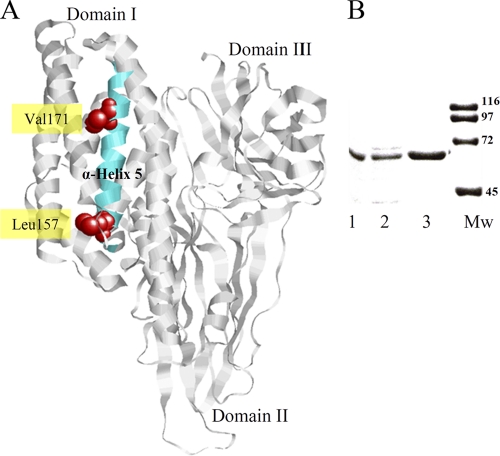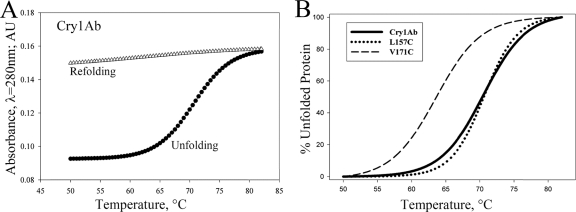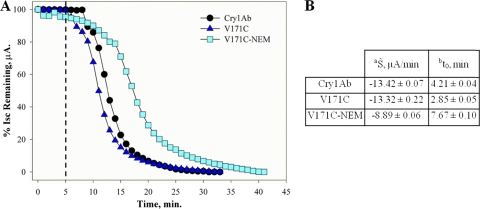Abstract
The Cry1Ab δ-endotoxin V171C mutant protein exhibits a 25-fold increase in toxicity against Lymantria dispar, which correlates with a faster rate of partitioning into the midgut membrane and slightly decreased protein stability. This is an insect-specific mechanism; similar results were not observed in Manduca sexta, another Cry1Ab δ-endotoxin-susceptible insect.
δ-Endotoxins are insecticidal proteins synthesized by the bacterium Bacillus thuringiensis (12). The δ-endotoxins have been used for controlling insect species of the orders Lepidoptera, Diptera, and Coleoptera (12), among others. The Cry1A δ-endotoxin family in its active conformation has three structural domains (6). Domain I is an α-helical bundle of 7 to 8 α-helices characterized by the centrally located, hydrophobic α-helix 5 (Fig. 1A). This domain is involved in insertion of protein into the insect's midgut membrane, producing ion pores or ion channels that result in death of the insect (reviewed in reference 12). To probe the active conformation of the Cry1A δ-endotoxins in the insect's midgut membrane, we created a series of mutant proteins that have been analyzed by biophysical techniques, including electron paramagnetic resonance (2), membrane partitioning assays (1-3, 10), and fluorescence spectroscopy (10). The single mutation of valine 171, located in α-helix 5 (Fig. 1A), to cysteine (V171C) resulted in a toxin with a 25-fold increase in toxicity against Lymantria dispar. Our data suggest that Val171 is involved in the translocation of the protein into midgut membranes of this target insect.
FIG. 1.
(A) Three-dimensional image of Cry1Ab δ-endotoxin created by molecular modeling as described in reference 1, indicating α-helix 5, Val171, and Leu157. (B) Analysis by SDS-10% PAGE of the Cry1Ab (lane 1), L157C (lane 2), and V171C (lane 3) toxins. Lane 4 shows molecular weight markers (Bio-Rad).
Mutant proteins V171C and L157C, which was used as a control because of its location on α-helix 5 (Fig. 1), were created and purified as described previously (2, 3), producing activated toxins similar in size to that of the wild-type Cry1Ab δ-endotoxin (Fig. 1B). For a diet surface contamination assay described previously (3), 3-day-old larvae were fed an artificial diet contaminated with a toxin. Twenty Manduca sexta and 80 L. dispar larvae were used for each concentration. Toxicity assays (Table 1) demonstrated that toxicity differences are insect dependent. In M. sexta, the V171C and L157C mutants exhibited 2-fold-less toxicity than Cry1Ab. In L. dispar, the V171C and L157C mutants exhibited 25- and 4-fold increases in toxicity, respectively, compared to Cry1Ab.
TABLE 1.
Comparisons of the toxicity of CrylAb and the L157C and V171C mutants in M. sexta and L. dispar
| Toxin | LC50a (ng/cm2) for: |
|
|---|---|---|
| M. sexta | L. dispar | |
| Cry1Ab | 36.00 (19.9, 57.8) | 262.17 (211.5, 324.2) |
| L157C | 78.60 (51.3, 143.3) | 56.97 (25.2, 84.7) |
| V171C | 75.80 (41.3, 115.0) | 10.44 (7.6, 14.4) |
LC50, lethal median concentration for 50% kill, determined by probit analysis of surface contamination assays. Values in parentheses are 95% confidence limits.
We used UV-visible spectroscopy (UV/VIS) and circular dichroism (CD) spectroscopy to determine whether the increased toxicity resulted from structural alterations. As previously reported (10), CD revealed that the secondary structures of the mutant and the wild-type toxins are virtually identical. We then studied whether the folding and/or unfolding rate of the toxins showed any differences that could account for the observed changes in toxicity. A 30-μg aliquot of each toxin dissolved in 3.0 ml of 10 mM phosphate buffer (pH 7.4) and 1.5 M guanidine hydrochloride (GuHCl) was placed in a 1.0-cm rectangular cuvette (Hellma). The temperature was increased from 20 to 84°C with an incremental temperature change (ΔT) of 2.0°C and with continuous stirring, using an HP89090 Peltier temperature controller (Hewlett-Packard). Unfolding and refolding were followed under the same conditions with a 20-min equilibration time for each temperature. Absorbance spectra in the range 200 to 300 nm were collected with a Hewlett-Packard UV/VIS spectrophotometer. Unfolding of the δ-endotoxins requires performing thermal denaturation in the presence of at least 0.5 M GuHCl to produce detectable levels (personal observation). The thermal unfolding of Cry1Ab is a nonreversible process (Fig. 2A); therefore, we could not apply equilibrium thermodynamics to determine the structural energetics of this protein. Nonetheless, heat denaturation can be used to measure the temperature at which 50% of the protein population reaches the unfolded state (Tm). The Tm for the V171C mutant (Tm-[V171C]), 63.45 ± 2.5°C, is approximately 7°C lower than the Tm for CrylAb (Tm-[Cry1Ab]), 70.52 ± 3.0°C, and the Tm for the L157C mutant (Tm-[L157C]), 70.40 ± 2.7°C (Fig. 2B). Comparison of the Tm value for the V171C mutant with that for the L157C mutant, a mutant toxin that showed a slight increase in toxicity against the same insect, suggests that the increase in toxicity of the V171C mutant could be correlated with this toxin's decreased ability to keep a folded conformation compared to that of either Cry1Ab or the L157C mutant.
FIG. 2.
(A) Thermal unfolding of Cry1Ab wild-type toxin. The toxin unfolds when the temperature is increased (•). When the temperature is decreased under the same conditions, the toxin remains in the unfolded state (▵). (B) Thermal unfolding of the V171C mutant (Tm = 63.45 ± 2.5°C), the L157C mutant (Tm = 70.40 ± 2.7°C), and wild-type Cry1Ab (Tm, = 70.52 ± 3.0) toxins. AU, absorbance units.
We have previously demonstrated that the rate of protein insertion into the midgut membrane and the rate of ion transport usually correlate with toxicity (1, 3). We therefore analyzed the partitioning and the ion transport rates for the V171C mutant using voltage clamping (Vc) by measuring the inhibition of short-circuit current (Isc) as previously described (2). Isc is characterized by lag time (t0) and rate of ion channel formation (ŝ) (2, 3). These parameters can be used to determine whether the mutation had any effect on the ion channel properties of the toxin. Comparing the Isc values for Cry1Ab and the V171C mutant indicated similar ion channel formation (Fig. 3) and a 34% increase in insertion rate for the V171C mutant, results that correlate with the toxicity assays. The role of this new cysteine residue was probed by Vc in the presence of 15% N-ethylmaleimide (NEM), a membrane-permeable compound known to specifically react with sulfhydryl groups (7). NEM delays the insertion time from 2.85 ± 0.05 min to 7.67 ± 0.10 min, suggesting that the original Val171 is indeed involved in the partitioning process of the toxin. Isc was also hampered by NEM, as the slope went from −13.32 μA/min to −8.89 μA/min (Fig. 3). Vc experiments with the L157C mutant indicate that the insertion time is similar for the NEM-modified toxin (data not shown). In conclusion, there is a correlation between increased toxicity and increased partition into midgut membranes and the decreased thermal stability of the V171C mutant.
FIG. 3.
Inhibition of short-circuit current, Isc, determined by voltage clamping. (A) Percentage of Isc remaining for Cry1Ab and the V171C and V171C-NEM mutants. The dashed line shows the time at which the toxin was added to the Vc chamber. (B) (a) Slope of the inhibition of short current versus time as a measure of the rate of ion channel formation. (b) Lag time, the time needed for the short-circuit current to drop ∼10% from its initial value (3).
Protein engineering has been used to successfully manipulate the biological properties of δ-endotoxins (4, 8, 9, 11). As we previously demonstrated for Manduca sexta, the replacement of Val171 with cysteine results in a 2-fold decrease in toxicity and better ion channel formation than those of Cry1Ab, without altering other properties (10). Here we found that the V171C mutant increased its toxicity toward L. dispar 25-fold by increasing its rate of partitioning into the target membrane. Analysis of protein-receptor binding with an iodine-labeled toxin did not show differences between Cry1Ab and the mutant toxins (data not shown), in agreement with overall studies indicating that domain I is not specifically involved in protein binding.
We cannot rule out the possibility that unknown interactions between the newly introduced cysteine residue and the midgut membrane affect ion channel formation. The molecular mechanism by which the V171C mutant increases the toxicity of Cry1Ab may result from the increase in the unfolding rate of the V171C mutant by allowing the protein to partition more rapidly into the midgut membrane. At this point, we do not have molecular evidence that accounts for the differences in toxicity against M. sexta and L. dispar. A previous study by Fortier et al. reported that midgut juice or membrane-bound proteases affect the toxicity of Cry1Ab (5). Therefore, it is clear that these toxicity differences found in M. sexta and L. dispar may result from host-dependent mechanisms. We present here a Cry1Ab mutant toxin in which the rate of partitioning has been improved, resulting in higher toxicity toward L. dispar.
Acknowledgments
This research was supported by a grant (NIH R01-AI 29092) to D. H. Dean. O. Alzate is a fellow of the Colombian Institution for the Advancement of Science (COLCIENCIAS).
We thank Amir Abdullah (InsectiGen, Inc.) for a careful review of the manuscript.
Footnotes
Published ahead of print on 1 October 2010.
REFERENCES
- 1.Alcantara, E. P., O. Alzate, M. K. Lee, A. Curtiss, and D. H. Dean. 2001. Role of α-helix seven of Bacillus thuringiensis Cry1Ab δ-endotoxin in membrane insertion, structural stability, and ion channel activity. Biochemistry 40:2540-2547. [DOI] [PubMed] [Google Scholar]
- 2.Alzate, O., C. F. Hemann, C. Osorio, R. Hille, and D. H. Dean. 2009. Ser170 of Bacillus thuringiensis Cry1Ab δ-endotoxin becomes anchored in a hydrophobic moiety upon insertion of this protein into Manduca sexta brush border membranes. BMC Biochem. 10:25. [DOI] [PMC free article] [PubMed] [Google Scholar]
- 3.Alzate, O., T. You, M. Claybon, C. Osorio, A. Curtiss, and D. H. Dean. 2006. Effects of disulfide bridges in domain I of Bacillus thuringiensis Cry1Aa δ-endotoxin on ion-channel formation in biological membranes. Biochemistry 45:13597-13605. [DOI] [PubMed] [Google Scholar]
- 4.Audtho, M., A. P. Valaitis, O. Alzate, and D. H. Dean. 1999. Production of chymotrypsin-resistant Bacillus thuringiensis Cry2Aa1 δ-endotoxin by protein engineering. Appl. Environ. Microbiol. 65:4601-4605. [DOI] [PMC free article] [PubMed] [Google Scholar]
- 5.Fortier, M., V. Vachon, R. Frutos, J. L. Schwartz, and R. Laprade. 2007. Effect of insect larval midgut proteases on the activity of Bacillus thuringiensis Cry toxins. Appl. Environ. Microbiol. 73:6208-6213. [DOI] [PMC free article] [PubMed] [Google Scholar]
- 6.Grochulski, P., L. Masson, S. Borisova, M. Pusztai-Carey, J.-L. Schwartz, R. Brousseau, and M. Cygler. 1995. Bacillus thuringiensis CryIA(a) insecticidal toxin: crystal structure and channel formation. J. Mol. Biol. 254:447-464. [DOI] [PubMed] [Google Scholar]
- 7.He, M. M., J. Sun, and H. R. Kaback. 1996. Cysteine-scanning mutagenesis of transmembrane domain XII and the flanking periplasmic loop in the lactose permease of Escherichia coli. Biochemistry 35:12909-12914. [DOI] [PubMed] [Google Scholar]
- 8.Liang, Y., S. S. Patel, and D. H. Dean. 1995. Irreversible binding kinetics of Bacillus thuringiensis CryIA δ-endotoxins to gypsy moth brush border membrane vesicles is directly correlated to toxicity. J. Biol. Chem. 270:24719-24724. [DOI] [PubMed] [Google Scholar]
- 9.Liu, X. S., and D. H. Dean. 2006. Redesigning Bacillus thuringiensis Cry1Aa toxin into a mosquito toxin. Protein Eng. Des. Sel. 19:107-111. [DOI] [PubMed] [Google Scholar]
- 10.Nair, M. S., X. S. Liu, and D. H. Dean. 2008. Membrane insertion of the Bacillus thuringiensis Cry1Ab toxin: single mutation in domain II block [sic] partitioning of the toxin into the brush border membrane. Biochemistry 47:5814-5822. [DOI] [PMC free article] [PubMed] [Google Scholar]
- 11.Rajamohan, F., J. A. Cotrill, F. Gould, and D. H. Dean. 1996. Role of domain II, loop 2 residues of Bacillus thuringiensis CryIAb δ-endotoxin in reversible and irreversible binding to Manduca sexta and Heliothis virescens. J. Biol. Chem. 271:2390-2397. [DOI] [PubMed] [Google Scholar]
- 12.Schnepf, E., N. Crickmore, J. VanRie, D. Lereclus, J. Baum, J. Feitelson, D. R. Zeigler, and D. H. Dean. 1998. Bacillus thuringiensis and its pesticidal crystal proteins. Microbiol. Mol. Biol. Rev. 62:775-806. [DOI] [PMC free article] [PubMed] [Google Scholar]





